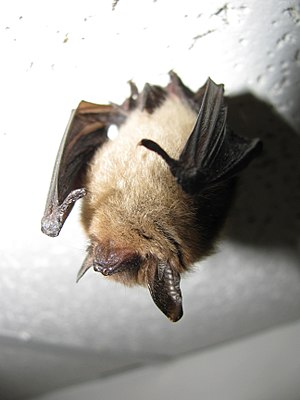Field Guide/Mammals/Northern Myotis
| Myotis septentrionalis (Northern long-eared myotis) | |
|---|---|
|
Family: Vespertilionidae
Size: The average length of the Northern myotis is 2.90- 3.3 inches (74-84mm) long, the length of the tail averaging at 1 inch (26mm), and it weighs between .17- .35 oz (5- 10g). They have a wingspan of 9-10 inches (22.86- 25.4cm).[1] Compared to other Myotis species, these bats have long ears with a relatively long tragus in each ear.
Description: The Northern myotis is a small bat with dull, gray-brown pelage. It has relatively long ears that extend beyond the tip of the nose when laid forward. It also has a narrow and sharp-pointed tragus, which is the externally visible cartilaginous structure of the external ear.[2][3]
Similar Species: Similar species of the Northern myotis include the Myotis sodalis and the Myotis lucifugus, from which it can be distinguished by having ears that extend beyond the tip of the nose when laid forward and a long, pointed tragus.
Range: The northern myotis is widely distributed over eastern and northern North America, but has been known to stretch all of the way down to Texas.[2]
Habitat: The Northern myotis hibernates in caves and mine tunnels. It is also found heavily in forested areas, and have been known to roost in buildings, under shingles of buildings, under exfoliating tree bark, and in caves and mines.[3][4]
Diet: The Northern myotis tend to forage in forest interiors, and their long ears allow them to find stationary insects. The diet focuses on moths, which often are often captured by gleaning, or plucking, the insects from a surface. They do eat other insects, which include caddisflies, beetles, flies, and leafhoppers, and generally hunt 1 to 3 meters from the ground.
Activity: During autumn, the Northern Myotis gathers into groups of a few hundred individuals for the purpose of mating, followed by hibernation. They forage at dusk or shortly after sunset and again at dawn, resting periodically throughout the night and roost during the day, being largely nocturnal.[3]
Reproduction: Mating occurs in autumn when groups of a few hundred, known as “swarming”, are formed and pairs mate before going into hibernation. The gestation period for he Northern myotis is 50-60 days, after which a single young bat is born. Young are generally born in late June or early July. Female bats nurse their young for about a month, and give birth to one young bat a year.[5]
Lifespan: Northern Myotis have been known to live up to 18.5 years.[3]
Notes: Male and female Northern Myotis bats roost separately; however, females with offspring may form small maternity colonies of less than 60 individuals.
Northern bats have good hearing and they often listen for sounds made by their insect prey. They also use echolocation to locate insects resting on leaves, tree trunks, or on buildings. As in the case with most bats, many humans consider northern bats to be pests. Bats often work their way into attics of houses and may carry a threat of rabies, although this is often exaggerated. The females of this species are generally larger and heavier than the males. There was only one reported specimen from Winterhaven in Dimmit County in Texas, making it doubtful that resident populations of this species occur in Texas.[3] Bats are the only mammals capable of flight. Long-eared bats are more of a forest dweller than other Myotis species. They are much more solitary in habits than other Myotis, generally found singly or in small groups containing up to 100 individuals.[1] Although sperm is transferred to the female during copulation that occurs in the fall, ovulation and fertilization of the egg are delayed until the females arouse from hibernation the following spring.[5] |
 |
- ↑ a b
Bat Conservation of Wisconsin, retrieved (October 15, 2012)
{{citation}}: Check date values in:|accessdate=(help) - ↑ a b
Northern Myotis, retrieved (October 15, 2012)
{{citation}}: Check date values in:|accessdate=(help) - ↑ a b c d e
Northern Myotis - Myotis septentrionalis, retrieved (October 15, 2012)
{{citation}}: Check date values in:|accessdate=(help) - ↑
Arroyo-Cabrales, J; Alvarez Castaneda, S. T. (2008), The IUCN Red List of Threatened Species, retrieved (October 15, 2012)
{{citation}}: Check date values in:|accessdate=(help) - ↑ a b
Kansas Mammal Atlas: Northern Myotis, (1999), retrieved (October 15, 2012)
{{citation}}: Check date values in:|accessdate=and|year=(help)